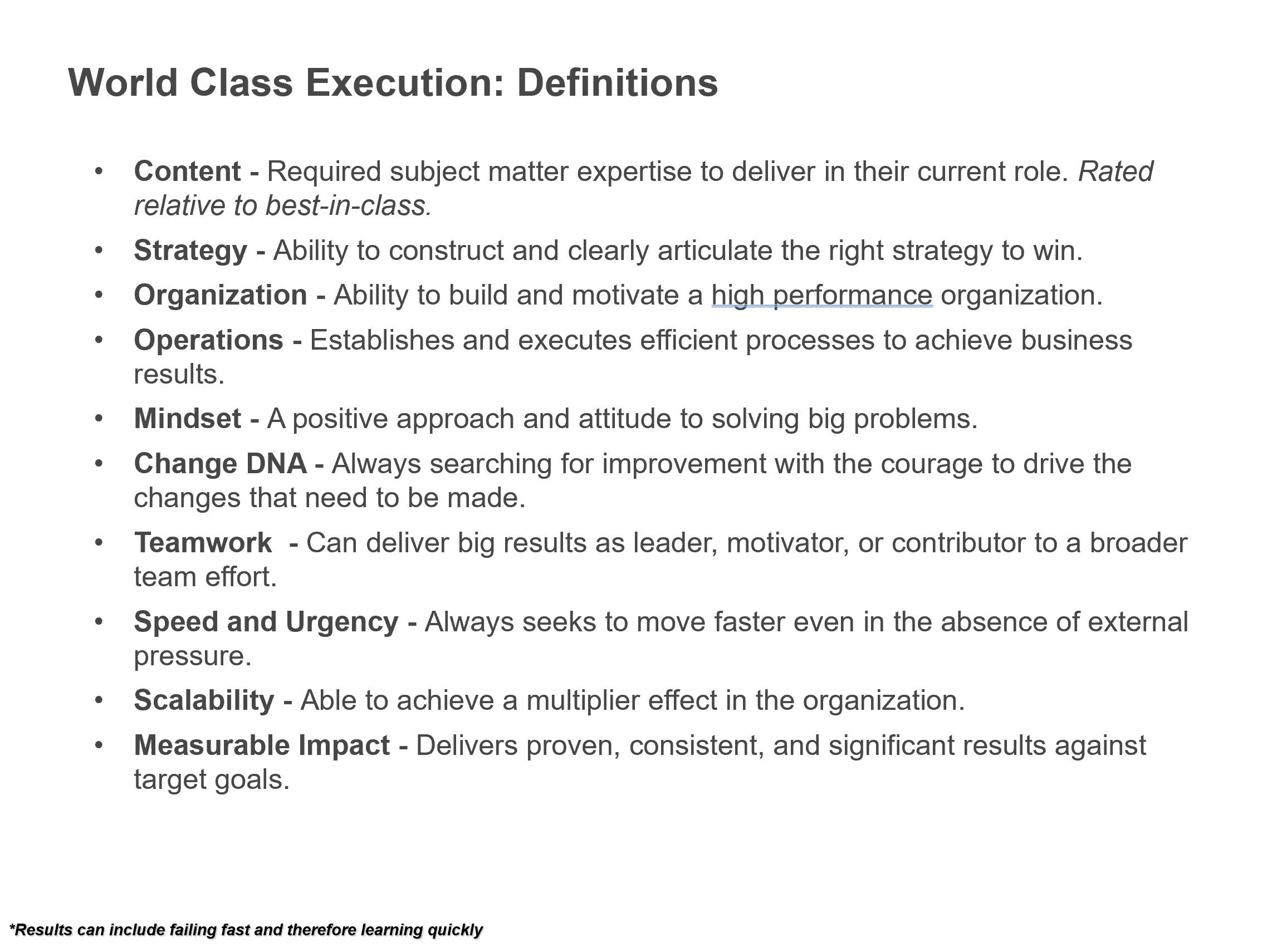Set 2: Delivering for All Four Stakeholders
Building a world-class execution team might be one of the hardest things to do and sustain. Organizations by their systemic nature will invariably regress to the mean talent over time—which means that you have to put perpetual and focused energy into your organizational priorities in order to offset that degradation (see Prioritization section for more). The above framework defines my personal approach to the types of people I bring into an organization, how those people are measured over time, how feedback is given, and more. It is vertically and horizontally scalable (in other words it applies to every individual at every level of the organization, no matter what their function). The three foundational elements are on the left, with sub-component break-outs on the right. Definitions for each of these elements are listed on the next slide. One of the unique aspects of this framework is in the ‘Energy Accretive’ characteristic. It’s a more subjective dimension, rated predominantly through peer feedback, that captures whether this person brings the net energy and output of the team to a higher level once they are added to the mix. The opposite, what I call 'Energy Dilutive’, is when the person actually slows down the execution fly-wheel because of their negative mindset, their inflexibility, their inability to work effectively across teams, etc.
Definitions for the Leadership Framework presented on the previous slide. When assessing an individual in a new role it is very common if not expected for a person to go from ‘green’ to ‘yellow’ or even ‘red’ on many of these dimensions. I’ll take the example of the stellar individual contributor developer, recently promoted into a management role, overseeing a team of five. In his previous role this person could very well have been ‘green’ on the dimension operations because as an individual contributor he was flawless in execution, always delivered his results on time, etc. However, as he moves into a management role the scope of his operations by definition expands. Now on deck to ensure that an entire team delivers at a high level, he might click down to ‘yellow’ for several years until he has proven definitive and sustained mastery of this dimension.
In the new connected world the speed of customer feedback (either positive or negative) becomes nearly instantaneous. Because of this increase in feedback velocity businesses must ultimately deliver a positive customer experience in order to survive. And to thrive and win requires moving that bar to an even higher state—to something that fundamentally changes the game (in other words, changes the customer expectation of what ‘good’ actually means). This requires a business model that can support the necessary investments (whether those investments are in experience improvements or price reductions) coupled with an actual experience that over-delivers on expectations at critical moments. Build connected flows into your business model in order to shift from an island to an ecosystem (for more details, see my deck on Connected Business Models elsewhere on this site). Finally, I would emphasize the incredible effect of speed on how customers perceive an experience (this applies primarily to ‘connected’ products and services). It could be the speed of an interface, the speed of getting set-up and using a product, etc. Truly game-changing companies have cracked the formula not only on how to deliver speed in response to customer action but also on how to predict customer needs before they even express them (what I call predictive speed).
I harbor a fundamental belief that if you are given the gift of controlling any scale lever in the society (and the leaders of any major organization or enterprise have been bestowed with that gift) you have a societal obligation to ensure that your business is creating net positive impact in the society. That is not to say that you can’t run a for-profit commercial enterprise. I would contend that most businesses that contribute meaningful services or products to the world add real and positive value. It does mean, however, that opportunities for creating social improvement, if adjacent to your business, should be actively pursued. And maybe more importantly, it implies that every leader needs to continually assess the second order effects of their business—which are often incredibly difficult to measure but can be insidious and significant in their impact. The 4th Stakeholder Papers go into significantly more detail on this incredibly important topic.
This slide doesn’t go deeper into Shareholder Value creation (that is a subject that can consume entire libraries). However, it does depict my expectations for anyone in my organization in terms of how I view financial rigor and planning. In a nutshell I am a huge believer in an iterative, zero-based financial process that is adjusted whenever new critical information comes into the system (event based vs. simply running on a calendar). Also, a simple rule of thumb that I apply in terms of scope of knowledge is what I have termed the 1% rule: if you are managing a $1M budget then I would expect you to have fairly in-depth knowledge of any $10K spend (or greater) that occurs in your organization.




